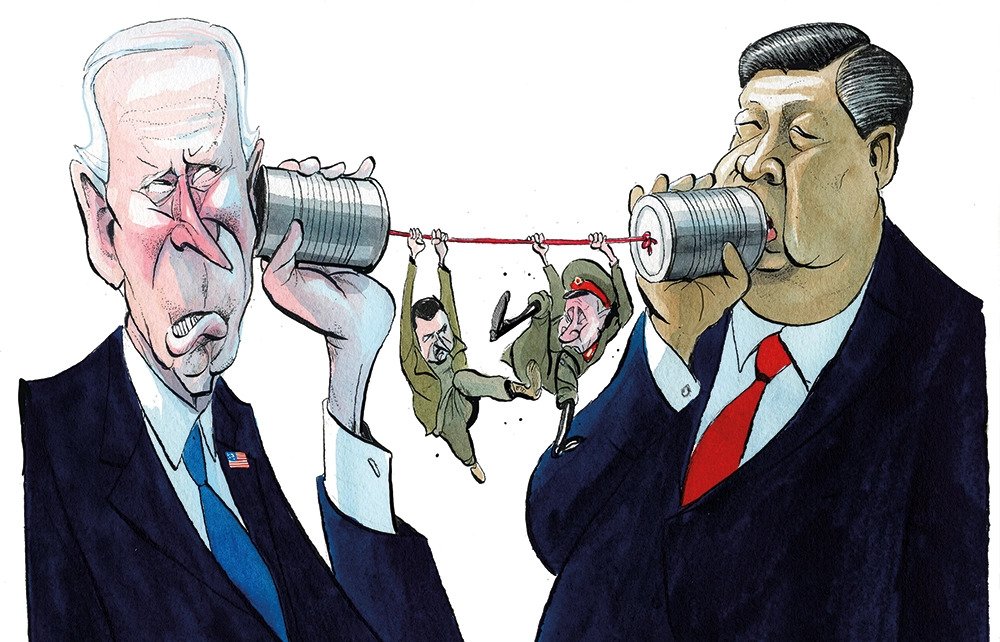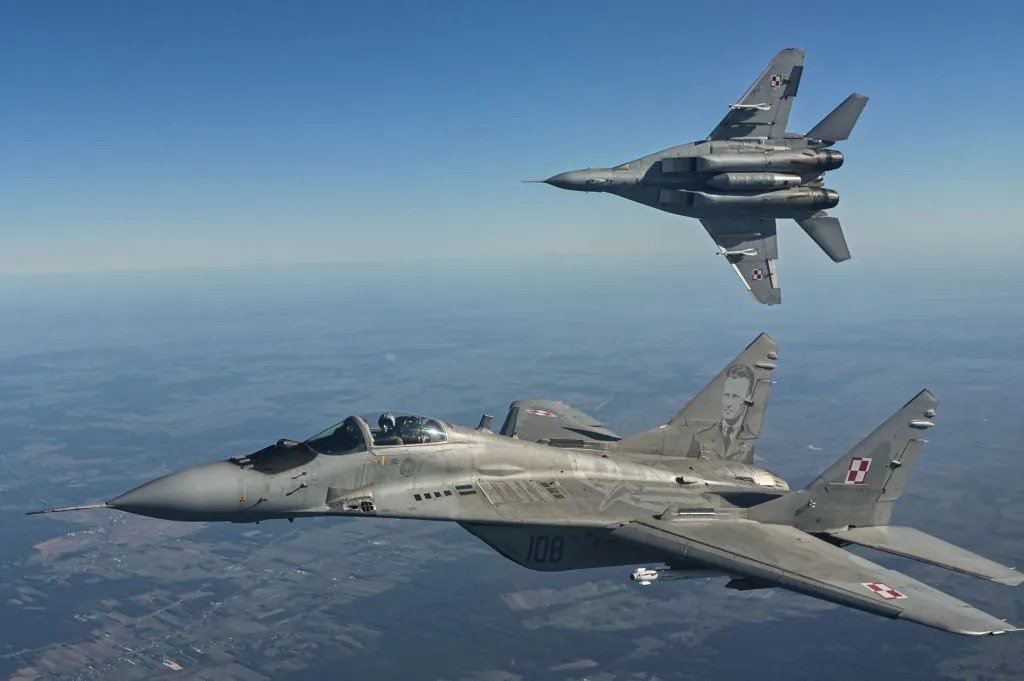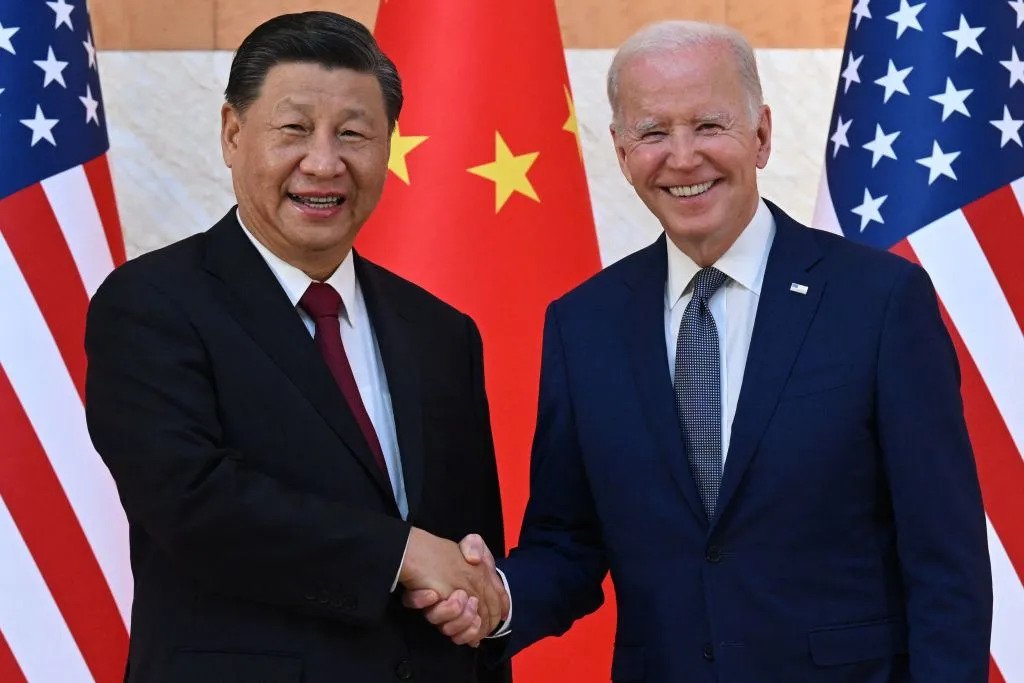
The red line: Biden and Xi’s secret Ukraine talks revealed
25 November 2022
Since the beginning of Russia’s invasion of Ukraine, China has played a decisive – though publicly low-profile – role in strategic decision-making in both Washington and Moscow. As I report for the first time in my new book Overreach, it was a back-channel intervention approved by Beijing that caused the US to scupper a deal for the Poles to provide Soviet-made MiG-29 jets to the Ukrainian Air Force back in March. And since September a flurry of personal diplomacy by Chinese foreign minister Wang Yi with Nato and the US has led to a rare moment of public agreement over Russia, when Xi Jinping said that the world ‘needs to prevent a nuclear crisis on the Eurasian continent’ in a meeting with Joe Biden at the G20 summit in Bali.
Throughout the war, China’s true position on the Russia-Ukraine conflict has been hard to pin down – not least because Beijing has been telling both sides what they want to hear. In March, Wang implicitly appeared to be blaming the US for ‘stoking tensions’ and ‘sowing discord’ with Russia. Last month he told his Russian counterpart, Sergei Lavrov, that ‘China will also firmly support the Russian side, under the leadership of President Putin, to unite and lead the Russian people’, according to state broadcaster CCTV. Wang also promised that ‘China is willing to deepen contacts with the Russian side at all levels’. Yet in September, on the sidelines of the UN General Assembly, Wang had told Nato Secretary-General Jens Stoltenberg that China ‘stays open-minded to dialogues and exchanges with Nato and is willing to jointly promote the sound and steady development of bilateral relations … in the spirit of honesty and mutual respect’.
So whose side is Beijing really on? The reality is that China has consistently backed only one side – its own. But the illusion of Chinese support was one of the many miscalculations that led Vladimir Putin down the road to war. At a summit in Beijing on 4 February this year, Xi and Putin announced a ‘friendship without limits’ with ‘no forbidden areas’ of cooperation. Both leaders declared the new level of Sino-Russian strategic partnership ‘superior’ to the alliances of the Cold War era. Beijing was aware of Russia’s plans for a military operation, according to a source with longstanding close ties to the top levels of China’s political and military leadership. But the Russians presented the coming military operation as a ‘limited operation to recover a lost Russian province [and] reunite Russia within historical boundaries’. That narrative fitted China’s own over Taiwan – though it was made clear that the Russian operation must not interfere with the Beijing Winter Olympics, which ended on 20 February – four days before Putin’s invasion.
Most importantly, in a confidential annexe to the ‘friendship without limits’ was a mutual security guarantee that Russia had sought from China for decades but hitherto been unable to obtain, said the source. Like Nato’s Article 5 – that an attack on one member is an attack on all – Beijing and Moscow pledged to come to each other’s aid militarily in the case of a foreign invasion of their territory and if special conditions were satisfied concerning the cause of such an invasion. That extremely canny and prescient proviso, inserted at Chinese insistence, would effectively exclude territories recently annexed during wartime, thus releasing Beijing from any commitment to respond to attacks on annexed territories in Ukraine.
The scale of Russia’s military operation – in particular the closely held secret of the blitzkrieg attack on Kyiv, of which even Lavrov was unaware as late as 21 February – took Beijing by surprise. Though the Chinese officially supported Putin diplomatically, blaming Nato for provoking the conflict, there was deep (and entirely well-founded) concern that Putin had overreached and would provoke the West into a united front that a limited operation in Donbas would have avoided. Putin’s threat of nuclear escalation on 27 February alarmed the world, including the Chinese. A key priority for Beijing was for the Russo-Nato confrontation to ‘avoid any nuclear escalation and to help in reaching a ceasefire’, said the source, who has regular personal contact with the leaders of the People’s Liberation Army (PLA). Now Putin had – recklessly in Chinese eyes – played his most dangerous card right at the beginning of the conflict.
So when, a few days later, a further escalation threatened in the form of an offer by the Polish government to supply Ukraine with its entire fleet of Soviet-era MiG-29 fighters, the Chinese grew concerned. In truth, there was little likelihood of the Polish MiGs making much difference on the battlefield. Poland’s 26 to 33 MiG-29s had been made in the early 1980s for the East German Air Force and had been sold to Warsaw for the symbolic sum of €1 each in 2003. Romania, which owned 20 similar MiG-29 jets, had decommissioned them many years ago. Nonetheless, a Nato country providing fighter jets of any kind to Kyiv represented an important symbolic, if not necessarily operationally significant, step towards direct Nato involvement in the conflict. Initially, Washington was positive. But a day later, on 8 March, the Pentagon abruptly reversed its position, pronouncing Poland’s proposal ‘not tenable’.
What changed Washington’s mind? In part, it was an urgent and confidential back-channel initiative involving former European leaders and senior officials, and ultimately endorsed by the Chinese. Ever since Putin’s 27 February declaration on nuclear readiness, the PLA had also been reaching out through military-to-military (as opposed to diplomatic or political) channels to senior Russian general officers with whom they had made personal contact over years of joint military exercises and military procurement talks. Beijing’s aim was to ensure that even if there were a political decision to use nukes, the Russian army would insist on sticking to its long-standing nuclear military doctrine to use them solely if provoked by attacks on Russian soil. Through these unofficial ‘track two’ contacts, Washington and the PLA agreed – unusually, given a deterioration in relations during the Donald Trump presidency – that if the US stopped the MiG deal, Beijing’s generals would do their best to defuse Putin’s nuclear threat on an operational level. ‘It worked,’ said the Chinese source. ‘The [US] decided that supplying aircraft was a step too far.’
Though this back-channel initiative of early March has not been previously reported, the fact that the US retained a fundamentally cautious attitude to supplying strategic weapons to Ukraine throughout the war effectively confirms that Washington, remained deeply aware of Chinese concerns, which were shared with many of the largest nations in the European Union. Despite a dramatic escalation in supplies of money and military hardware – including Nato-standard 155mm artillery capable of firing guided shells and the High Mobility Artillery Rocket System – Nato has held back on providing attack aircraft, helicopters, Nato-standard tanks, long-range battlefield missile and cruise missile systems.
At the same time, Chinese backing for Moscow remained equally cautious. Beijing offered diplomatic and informational support – but excluded significant military cooperation, forcing the Russians to buy drones from Iran, cannibalise domestic appliances for computer chips and attempt to buy back helicopters, missiles and missile defence systems from its military customers around the developing world. The threat of US sanctions on their global operations caused many leading Chinese banks such as ICBC, the New Development Bank and the Asian Infrastructure Investment Bank to withdraw credit and financing from Russia. Chinese energy giants such as Sinochem also suspended all Russian investments and joint ventures. In August, UnionPay – the Chinese equivalent of Visa and Mastercard – also ceased its cooperation with Russian banks, citing sanctions. The material motivation for Beijing’s corporations to pull out of Russia was clear: before the war China did $100 billion in trade with Russia (rising by a projected $30 billion this year thanks to increased oil imports) but more than $1.5 trillion with the US and EU.

With Biden and Xi’s joint condemnation of the threat of nukes at Bali earlier this month, the so-called ‘track two’ understandings of March have become a ‘track one’ public policy. Thanks to Wang’s shuttle diplomacy, Nato and China have effectively aligned on not escalating the Ukraine-Russia conflict, according to the Chinese source. Over a series of meetings with Nato leadership since early September, Wang pledged to use China’s considerable leverage in Moscow to dissuade Putin from using nukes, while in return Nato has affirmed that they would not provide strategic weapons to Ukraine.
At the Bali summit Xi (backed by Indian Prime Minister Narendra Modi) publicly called for a ‘return to diplomacy and stressing the urgency in finding a peaceful resolution’. That’s a position yet to be officially embraced by Nato, which insists that the Ukrainians will decide when to come to the negotiating table. But many senior voices in Nato – for instance the US chairman of the joint chiefs of staff Mark Milley and France’s Emmanuel Macron – have independently suggested that Kyiv should prepare for peace talks. And China’s security guarantees of Russia’s pre-invasion borders made back in February could play an important role in building a face-saving off-ramp for the Kremlin as a counter to Nato’s likely security guarantees for Ukraine.
China’s price for its peacemaking? Beijing hopes to improve relations with Nato and Europe and bring an end to a bloody and futile war that its ally Putin began so recklessly. In Ukraine, China is, in the words of the source, ‘ultimately positioning herself as our last hope for peace in this world’. The Ukrainians, who will likely be asked to sacrifice land for peace, may disagree.
Source: The Spectator












